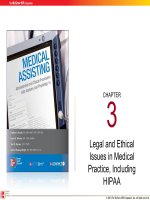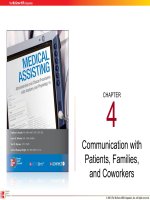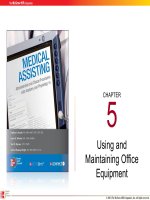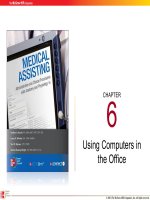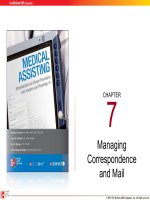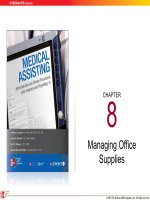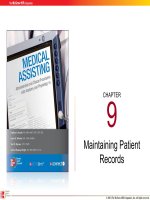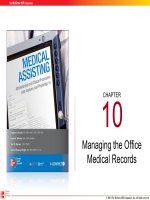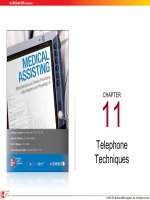Lecture Medical assisting: Administrative and clinical procedures with anatomy and physiology (4e) – Chapter 14
Bạn đang xem bản rút gọn của tài liệu. Xem và tải ngay bản đầy đủ của tài liệu tại đây (1.42 MB, 43 trang )
CHAPTER
14
Patient Education
© 2011 The McGraw -Hill Com panies, Inc. A ll rights reserv e d.
14-2
Learning Outcomes
14.1 Identify the benefits of patient education.
14.2 Explain the role of the medical assistant in
patient education.
14.3 Discuss factors that affect teaching and
learning.
14.4 Describe patient education materials used in
the medical office.
© 2011 The McGraw -Hill Com panies, Inc. A ll rights reserv e d.
14-3
Learning Outcomes (cont.)
14.5 Explain how patient education can be used to
promote good health habits.
14.6 Identify the types of information that should
be included in the patient information packet.
14.7 Discuss techniques for educating patients
with special needs.
© 2011 The McGraw -Hill Com panies, Inc. A ll rights reserv e d.
14-4
Learning Outcomes (cont.)
14.8 Explain the benefits of patient education prior
to surgery, and identify types of preoperative
teaching.
14.9 List educational resources that are available
outside the medical office.
© 2011 The McGraw -Hill Com panies, Inc. A ll rights reserv e d.
14-5
Introduction
• Health education = lifelong pursuit
• Medical professionals
– Encourage and teach health habits and
behaviors
• Medical assistants
– Recognize and overcome roadblocks to
education
– Become comfortable with teaching
– Lead others to their highest level of health
© 2011 The McGraw -Hill Com panies, Inc. A ll rights reserv e d.
14-6
The Educated Patient
Is better informed about how to
maintain a healthy state
Is often more compliant with treatment
programs
Takes a more active role in medical care
© 2011 The McGraw -Hill Com panies, Inc. A ll rights reserv e d.
14-7
The Educated Patient (cont.)
• Benefits to the medical office
– Patients are more satisfied
– Patients are more likely to follow instructions so tests
do not have to be rescheduled
– Patients are less likely to call the office with
questions, so staff spends less time on the telephone
• Medical assistant
– More interaction with the patient
– Assess educational needs at every visit
© 2011 The McGraw -Hill Com panies, Inc. A ll rights reserv e d.
14-8
Apply Your Knowledge
What are the results of patient education?
ANSWER: Patients can take a more active role in their
health care. They are more compliant with the treatment
program, stay healthier, and are more satisfied clients of
the medical practice.
EXCELLENT!
© 2011 The McGraw -Hill Com panies, Inc. A ll rights reserv e d.
14-9
Printed Materials
Brochures, Booklets, and Fact Sheets
Explain procedures that are performed in
the medical office
Provide information about specific diseases
and medical conditions
Provide information to help patients stay
healthy
© 2011 The McGraw -Hill Com panies, Inc. A ll rights reserv e d.
14-10
Printed Materials (cont.)
Educational Newsletters
Medical office newsletters:
Are written by the doctor or office staff
Contain practical health care tips
Offer updates on office policies
Provide information about new diagnostic
tests and equipment
© 2011 The McGraw -Hill Com panies, Inc. A ll rights reserv e d.
14-11
Printed Materials (cont.)
Community-Assistance Directory
A valuable aid for referring patients to
appropriate agencies
Meals
on
Wheels
Medical
Services
Day
Care
Centers
© 2011 The McGraw -Hill Com panies, Inc. A ll rights reserv e d.
14-12
Visual Materials
Videotapes and DVDs are used effectively to
educate about complex subjects and procedures
Many physicians arrange classes
and seminars for their patients
Health information
websites for general
consumer health
information
© 2011 The McGraw -Hill Com panies, Inc. A ll rights reserv e d.
14-13
RIGHT!
Apply Your Knowledge
A medical assistant employed in a cardiology office is asked by
the physicians to create some form of publication to educate
patients about healthy heart habits. Which of the following
mediums do you feel will be most effective and why?
Answer:
A. Create a fact sheet with text explaining common heart
diseases.
Lack of pictures so this medium may not appeal
to patients.
B. Check out several books on healthy habits that affect the
heart from the local library.
Books cannot be removed from the office.
C. Create a brochure with pictures and text to focus on dietary
habits and other habits that affect heart functioning.
© 2011 The McGraw -Hill Com panies, Inc. A ll rights reserv e d.
Promoting Health and Wellness Through
Education
14-14
• Health is a complex concept involving physical,
mental, emotional, and social influences working
together
• Consumer Education has helped Americans
become more aware of good health practices
• Ways to achieve good health
– Develop good health habits
– Protect self from injury
– Take preventive measures to protect against disease
and illness
© 2011 The McGraw -Hill Com panies, Inc. A ll rights reserv e d.
14-15
Healthy Habits
Adequate Rest
Good Nutrition
Regular Exercise
© 2011 The McGraw -Hill Com panies, Inc. A ll rights reserv e d.
14-16
Healthy Habits (cont.)
Limit Alcohol
Intake
No Smoking
Work
Leisure
Balance
© 2011 The McGraw -Hill Com panies, Inc. A ll rights reserv e d.
14-17
Protection from Injury
• Safety tips to prevent
injuries
– At home
– At work
– At play
• Proper use of
medications
– Do not change dosage
– Do not mix
medications
– Report unusual
reactions
– Tell doctor about any
OTC medications
© 2011 The McGraw -Hill Com panies, Inc. A ll rights reserv e d.
14-18
Preventive Measures
Three Levels of
Prevention
Third Level
Rehabilitation
Secondary Level
Screening
Primary Level
Health-promoting
behaviors
© 2011 The McGraw -Hill Com panies, Inc. A ll rights reserv e d.
14-19
Apply Your Knowledge
Categorize each of the following behaviors as a
first, second, or third level of prevention.
ANSWER:
Tuberculin skin test
Monthly self-breast exam
Adopting healthy eating habits
Annual mammograms
Bladder retraining programs
© 2011 The McGraw -Hill Com panies, Inc. A ll rights reserv e d.
14-20
The Patient Information Packet
• Benefits of the information packet
– Improves relationships between the office and
patients
• Simple, inexpensive, and effective medium
– Provides important information about office policies
and staff roles
– Excellent marketing tool
All materials should be written at a sixth-grade level
© 2011 The McGraw -Hill Com panies, Inc. A ll rights reserv e d.
14-21
The Patient Information Packet (cont.)
Contents
•
•
•
•
•
•
Introduction to the office
Physician’s qualifications
Description of the practice
Introduction to the office staff
Office hours
Appointment scheduling
© 2011 The McGraw -Hill Com panies, Inc. A ll rights reserv e d.
14-22
The Patient Information Packet (cont.)
Contents
• Telephone policy
• Payment policies
• Insurance policies
• Patient confidentiality
statement
• Other information
© 2011 The McGraw -Hill Com panies, Inc. A ll rights reserv e d.
14-23
Distribution of Patient Information Packet
• Patients must receive and read the information
packet in order for the materials to be effective
– Hand the packet to new patients and review the
contents with them
– Mail the packet to patients prior to the initial visit if
time permits
– Keep additional copies available in the office where
patients can access them easily
– For patients with special concerns, pictures and
charts may be needed to communicate the
information
© 2011 The McGraw -Hill Com panies, Inc. A ll rights reserv e d.
The Patient Information Packet: Special
Concerns
14-24
• Patients who cannot read well or cannot
speak or understand English
– Use pictures and charts
– Translations
– Family or friends may be
able to read it to them
• Match learning materials to patient needs
and level of understanding
© 2011 The McGraw -Hill Com panies, Inc. A ll rights reserv e d.
14-25
Apply Your Knowledge
Following their office visit, several patients inquire about the
credentials of the practitioner seeing them during the visit.
How can this information be made available to the patients?
ANSWER: Using a digital camera or other device, take
photos of office personnel and place the photos with their
credentials in the office content packet.
IMPRESSIVE!
© 2011 The McGraw -Hill Com panies, Inc. A ll rights reserv e d.

